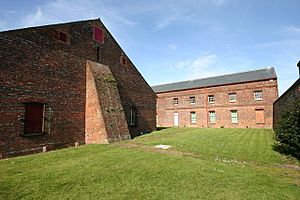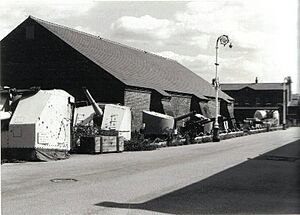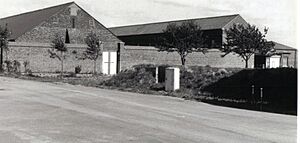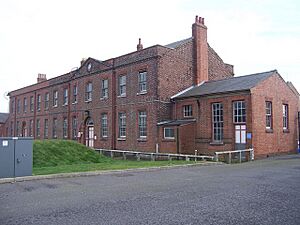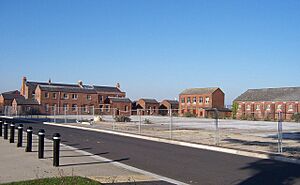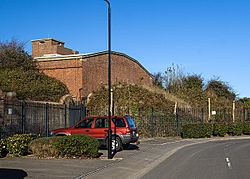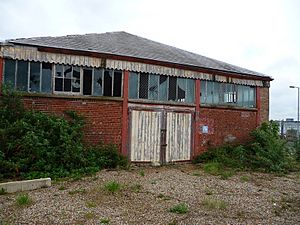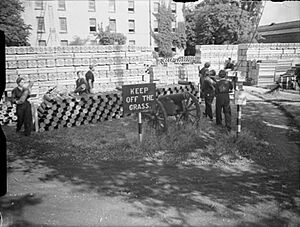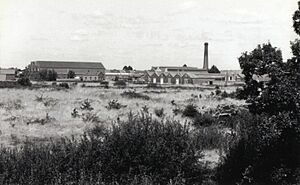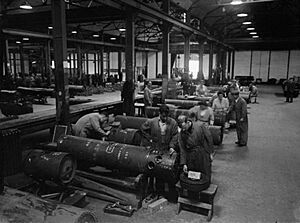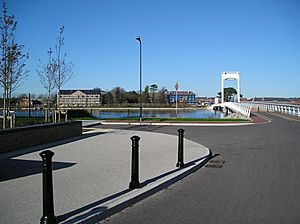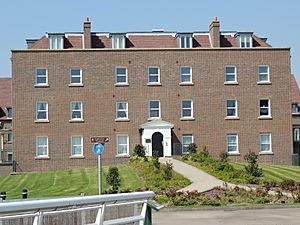Priddy's Hard facts for kids
Priddy's Hard is a special area in Gosport, Hampshire, England. For about 200 years, it was a secret place where the Royal Navy and British Army kept their weapons, explosives, and other supplies. Today, some of the area is being turned into homes, while another part is a museum.
Contents
History
The 1700s: A New Start
In 1750, King George III's government bought land in Gosport. They wanted to build a fort there to help protect Portsmouth Harbour and the Royal Dockyard. This fort, called Priddy's Hard Fort, was finished in 1757 and had 14 large guns.
Why Move the Gunpowder?
For a long time, gunpowder was stored in the Square Tower in Old Portsmouth. But this was very dangerous! People worried about explosions because:
- Gunpowder barrels were shaken in carts, leaving trails of powder in the streets.
- Sparks from torches at funerals could fly near the magazine.
- Drunken sailors often smoked near the gunpowder when loading it onto ships.
- The magazine was close to the sea, making it an easy target for enemy ships.
Imagine if it exploded! Many people would have been hurt. There had been terrible gunpowder accidents before:
- In 1649, 60 houses were destroyed in London.
- In 1654, 3,000 people died in Gravelines.
- In 1739, lightning struck a magazine in Brescia, killing 3,000 people.
So, the decision was made to move the gunpowder storage. Priddy's Hard was chosen because the land was already owned by the Crown.
Building the Main Storage Area
Building the new gunpowder storage, called the Grand Magazine, started in 1771. It took six years to finish. A tall brick wall was built around it to keep it safe. No metal objects, alcohol, or smoking materials were allowed inside to prevent sparks.
Boats were important for moving gunpowder. New powder arrived by barge from places like Faversham. It was then moved to and from ships using small sailing boats called hoys. A special basin, called a camber, was built so boats could unload closer to the magazine.
Barrels of gunpowder were moved between the camber and the magazine on a "rolling way." The barrels weren't rolled directly; they were put on trolleys. Two buildings were built next to the rolling way: one for checking the powder and another for fixing barrels. These later became the North and South Stores.
For security, a guardhouse was built near the main entrance. There was also a small barracks for soldiers. In 1783, a large house was built for the depot's senior officers.
More magazines were planned but cancelled. This meant there wasn't enough storage, especially during the Napoleonic Wars. So, old ships called hulks were used as floating gunpowder magazines.
By May 1777, the first gunpowder barrels arrived at Priddy's Hard from Portsmouth's Square Tower. From then on, Priddy's Hard worked with H.M. Gunwharf in Portsmouth. Priddy's Hard stored gunpowder, while Gunwharf stored other items like cannons and small arms. These depots supplied gunpowder and weapons for both the navy and the army.
Other Storage Sites
As soon as Priddy's Hard opened, Britain was often at war. Even with its large capacity, more storage was needed. So, other magazines were built to spread out the gunpowder and reduce the risk if one place was attacked.
- In 1796, a magazine was built at Tipner.
- In 1804, buildings were added at Stamshaw Point and Horsea Island to repair damp gunpowder.
- Three more magazines were built at Marchwood in 1814-16.
Priddy's Hard remained the most important of these sites.
The 1800s: Growing and Changing
In 1804, the rolling way was covered, and new buildings were added, like an office for the foreman and a "shoe room" where workers changed into special clothes. An office building and a new cooperage were built in 1811.
By 1846, Priddy's Hard had many buildings, including:
- 'A' Powder Magazine (for 6,222 barrels).
- 'B' Magazine (the joined North and South Stores).
- The rolling ways and adjacent offices.
- The Camber Basin.
- Storehouses, engine houses, and a boathouse.
- Houses for officers and staff.
The Royal Laboratory Arrives
In 1847-48, the Royal Laboratory, which made small arms ammunition, moved to Priddy's Hard from Portsea. This was a big change, as Priddy's Hard started focusing more on making things rather than just storing them.
Making Shells
As artillery shells became more common, filling shells and preparing fuzes became the main work of the Royal Laboratory. New buildings were added for shell making, all connected by a tramway.
- 1861: "C" Powder Magazine was built.
- 1865: Case Store for wooden shell boxes.
- 1866: Six Shell Filling Rooms (now gone).
- 1879: A Shell Store was built near a new pier for storing filled shells.
In 1879, a new magazine, "E" Powder Magazine, was built. It became the main storage magazine, replacing the older "A" magazine.
After an explosion in 1883, some shell-filling work moved to new buildings outside the main area, connected by tramway.
- 1886: New Shell Filling Rooms and Fusing Rooms (now gone).
- 1886: Expense Magazine for the Shell Filling Rooms.
- 1887: Unheading Room (where powder barrels were opened).
Facilities for filling new Quick Firing (QF) shells were also added.
- 1888: QF Shell Filling Room.
- 1889 & 1896: QF Shell Stores.
From the 1890s, new explosives like guncotton and cordite needed special buildings. Many of these were built outside the main ramparts.
- 1896: New Laboratory complex for filling cartridges.
- 1896: Shell Store (Building No 406).
- 1897: Twelve Cartridge Rooms.
- 1898: Cordite Magazine (Building No 454), a large storage magazine surrounded by a moat.
- 1899: New Shell Store (Building No 407, now gone).
- 1899: Mines and Countermines Store (Building No 409).
- 1900: Dry Guncotton Magazine and Wet Guncotton Magazine.
Priddy's Hard Tramway
In the 1860s, a small 18-inch wide tramway was built to move powder and ammunition. Its rails were made of a special metal called delta metal (a type of brass) to prevent sparks. It had 78 small trucks.
Later, a wider 2-foot 6-inch tramway, called the "shell tramway," was built with steel rails. It connected the shell-filling rooms to the shell stores. At first, workers pushed the trucks, but from 1929, battery-powered locomotives were used. The tramway stopped working in 1960, and many of the tracks were removed.
The 1900s: Wars and Changes
Priddy's Hard kept changing as new types of ammunition appeared. An explosion in 1904 led to a new storage facility being built further north at Bedenham.
During World War I, demand for ammunition increased a lot. More filling rooms were added for cartridges, tubes, and fuzes. New storage buildings for mines, bombs, and depth charges were also built. New explosives like TNT and amatol got their own processing rooms. A railway connection was added in 1914 to help load filled shells directly onto trains.
In 1923, H.M. Gunwharf in Portsmouth closed, and its naval facilities moved to Priddy's Hard. Priddy's Hard then became the main local depot for supplying ammunition and repairing all kinds of naval weapons, from machine guns to depth charge throwers. A "New Gunwharf" was opened at Priddy's Hard with a factory, foundry, and repair shops. It even had a testing range for rifles and pistols.
Priddy's Hard was very busy during World War II, with thousands of women working there.
For many years, Priddy's Hard was a key armaments depot for the Royal Navy and Army. Its importance slowly decreased over time. In 1971, the 18th-century buildings became a museum to show the depot's history.
The site was last used for major naval activity during the Falklands War in 1982.
Other Depots Nearby
During the 20th century, several other depots were set up under Priddy's Hard's control. These were called Royal Naval Armaments Depots (RNAD).
- RNAD Bedenham: Opened in 1908, it became the main storage for explosives. It was linked to Priddy's Hard by rail.
- RNAD Elson: Developed from the 1920s, it later became a repair facility for guided missiles.
- RNAD Frater: Established in 1918 for repairing and testing naval mines. Later, it worked on torpedoes.
The Priddy's Hard Railway
These depots were connected by a standard-gauge railway system from 1913. Special locomotives were used to prevent sparks. The railway network had over 18 miles of track and stopped operating in 1989.
Closing Down
In 1977, a plan was made to move all armament support activities from Priddy's Hard to Elson and Frater. Priddy's Hard was officially emptied by RNAD Gosport in 1988. The depots at Bedenham, Elson, and Frater are still in use today as part of Defence Munitions Gosport.
Present Day
The oldest part of Priddy's Hard is now open to the public as the Explosion! Museum of Naval Firepower. It opened in 2001 and is now part of the National Museum of the Royal Navy.
A new footbridge was built from Gosport town centre to help people access the area. New homes have been built, including a replica of the old Officers' Residence. In 2004, a fire led to the demolition of the large New Shell Store.
Outside the historic ramparts, many buildings have been removed for housing. However, a large area around the ramparts and north of Forton Lake was protected in 1998 as a special area for nature. This area includes two moated cordite magazines, which are home to great crested newts and other protected animals.
In 2009, the Portsmouth Naval Base Property Trust bought the Priddy's Hard site. They plan to develop the site and restore the historic buildings. Some areas have already been redeveloped for housing, while others are still empty. The site has 26 listed buildings.
In 2016, a grant was proposed to help restore seventeen listed buildings. Some might become homes, businesses, or community spaces, like a waterside pub/restaurant, accommodation for schools, or even a new Coastal Forces museum.
Images for kids


